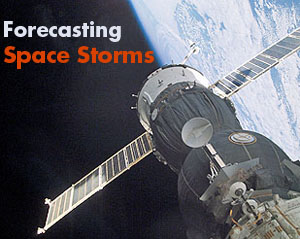Forecasting Space Storms
BU researchers work to predict dangerous bursts of radiation

Viewed from Earth with the naked eye, a starry sky is the picture of tranquility. But a team of Boston University astronomers, led by Harlan Spence (CAS’83), a College of Arts and Sciences astronomy professor, knows that space can sometimes roil with radiation storms fed by solar winds of a million miles an hour.
Such events are dangerous for both spacecraft electronics and astronauts. In an effort to learn how to forecast when the weather in space is about to get nasty, last month NASA awarded Spence and his multi-institutional research team a $42.5 million contract to design instruments for its Radiation Belt Storm Probe (RBSP) mission.
The scientists are focusing their research on a pair of radiation belts that begin 250 miles up and can extend for more than 30,000 miles into space. These belts within the Earth’s magnetosphere are filled with electrons and ions that can accelerate up to dangerous energy levels in minutes, usually resulting from huge bubbles of solar gas known as coronal mass ejections or from gusty solar winds buffeting Earth’s protective magnetic field.
“These radiation belt particles are constantly moving and can change energy by huge amounts,” Spence explains. “Our measurements will resolve the physical processes governing the variability of these energetic particles, which are one form of hazardous space weather.” Some particles travel at close to the speed of light, and they have enough energy to penetrate a spacecraft and damage its electronics or enter an astronaut’s body, which is a potential cancer risk.
“We are a space-faring society,” notes the Web site of Spence’s team. Space weather can damage a spacecraft’s navigational or life-support system or knock out a communications satellite, as happened in 1998 when a space storm disrupted 80 percent of all pagers in the United States. In addition, on at least one occasion astronauts on the International Space Station had to take cover in a designated safe area while their craft was bombarded with dangerous levels of high-energy charged particles.
The ability to forecast space weather will become increasingly important in the coming years, according to Barbara Giles, the program scientist for the geospace missions of NASA’s Living with a Star program, which includes Spence’s research team. “We’re becoming increasingly dependent on satellites and communication through space, and a great many of our nation’s space assets are flying in this region [of the radiation belts],” she says. While both the Space Shuttle and the International Space Station stay in lower, relatively safe orbits, Giles notes plans for another manned mission to the moon “and on from there at some point.”
“We really need to better understand space weather so that we can predict when there will be hazards to avoid,” she says.
Spence’s team is developing three pairs of particle instruments that will be sent into the radiation belts on two unmanned spacecraft as part of the NASA mission scheduled to launch in 2012. The instruments, each about the size of a toaster, will measure the nearby particles at different levels of energy and beam this information back to Earth.
Even before the NASA contract, BU was considered a leader in space weather research. For example, for four years BU has housed the Center for Integrated Space Weather Modeling (CISM). About 80 researchers spread across 10 institutions are affiliated with CISM, which is funded by the National Science Foundation and develops computer models of space weather, tracking the development of a space storm from the sun to the Earth’s magnetosphere.
“All these models have to work and communicate with each other,” says Jeffrey Hughes, a CAS professor of astronomy and CISM director. “We need to better understand the science of how this large, complicated system works.”
Indeed, while Spence’s team works on probes that will be getting data on particles in the Earth’s radiation belts, CISM will be working with the National Oceanographic and Atmospheric Administration to gather data from the Advance Composition Explorer (ACE), a NASA satellite that monitors the solar winds about a million miles away from Earth. In addition, four other teams of researchers are under NASA contract to design instruments for the RBSP mission to measure the electric and magnetic fields that surround our planet.
According to Nicola Fox, deputy mission scientist at the Applied Physics Laboratory of Johns Hopkins University, which is building the RBSP satellites that will carry the particle instruments, putting together a comprehensive picture of how space weather develops “is a bit like the blind men trying to get a sense of an elephant.” But Fox and the other researchers involved in the mission are all optimistic about their potential to improve the ability to forecast space weather.
“Over the years, we’ve developed a better understanding of how we should make measurements and what we should look for,” says Spence. “With the help of this research, we hope to move from a reactive to a proactive understanding of space weather.”